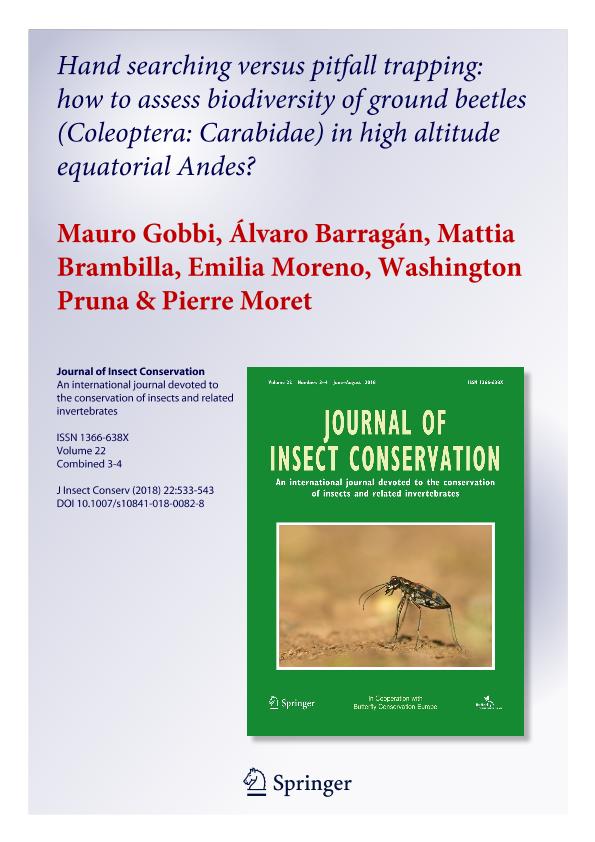Artículo
Hand searching versus pitfall trapping: how to assess biodiversity of ground beetles (Coleoptera: Carabidae) in high altitude equatorial Andes?
Gobbi, Mauro Javier; Barragán, Álvaro; Brambilla, Mattia; Moreno Coellar, Emilia ; Pruna, Washington; Moret, Pierre
; Pruna, Washington; Moret, Pierre
 ; Pruna, Washington; Moret, Pierre
; Pruna, Washington; Moret, Pierre
Fecha de publicación:
08/2018
Editorial:
Springer
Revista:
Journal of Insect Conservation
ISSN:
1366-638X
Idioma:
Inglés
Tipo de recurso:
Artículo publicado
Clasificación temática:
Resumen
The use of ground beetles (Coleoptera: Carabidae) as bioindicators of environmental change depends on the reliability and the effectiveness of the sampling methods. Those that have been tested in the temperate zone and in tropical forests still await experimentation in tropical high-altitude environments. For the first time, pitfall trapping and hand searching have been compared in Ecuadorian páramo above 4000 m a.s.l., in terms of practical effectiveness. The study was performed on six volcanoes and was based on the comparison of 28 sampling sessions (pitfall trapping and hand searching) performed along two different elevational belts [lower superpáramo (LSP) and upper superpáramo (USP)]. Analyses of sampling sessions showed that detected species richness is slightly higher with hand searching than with pitfall trapping, regardless of the elevation. Additionally, hand searching is more time-effective than pitfall trapping. The performance of the sampling method slightly varies when species assemblage composition is analysed in relation to elevational belts. In the LSP, hand searching and pitfall trapping should be simultaneously used to obtain exhaustive inventories of carabid biodiversity, since different species are likely to be collected by each method. In the USP, hand searching and pitfall trapping efficiency is very similar, but hand searching allows to collect a slightly larger number of species. Lastly, the sample-based rarefaction curves showed that four temporal replicates are mandatory to obtain a robust dataset and an exhaustive inventory of the true species richness and species assemblages composition. Our findings suggest a combined use of hand searching and pitfall trapping in the LSP, while both methods can be used alone for surveying carabids in the USP. Furthermore, hand searching is recommended if the aim is to obtain an inventory of species diversity, whereas pitfall trapping seems more convenient for fine grain ecological and comparative studies.
Archivos asociados
Licencia
Identificadores
Colecciones
Articulos(IFIBYNE)
Articulos de INST.DE FISIOL., BIOL.MOLECULAR Y NEUROCIENCIAS
Articulos de INST.DE FISIOL., BIOL.MOLECULAR Y NEUROCIENCIAS
Citación
Gobbi, Mauro Javier; Barragán, Álvaro; Brambilla, Mattia; Moreno Coellar, Emilia; Pruna, Washington; et al.; Hand searching versus pitfall trapping: how to assess biodiversity of ground beetles (Coleoptera: Carabidae) in high altitude equatorial Andes?; Springer; Journal of Insect Conservation; 22; 3-4; 8-2018; 533-543
Compartir
Altmétricas



